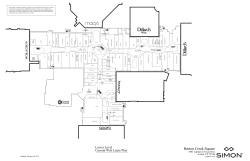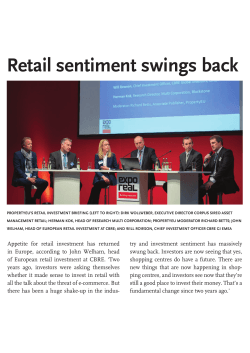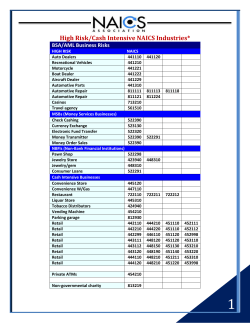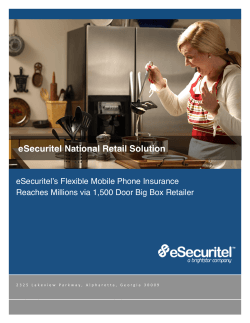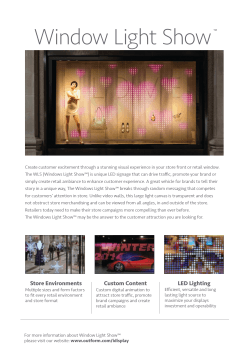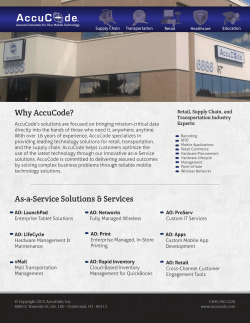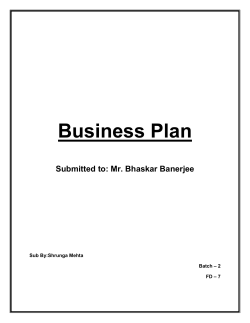
What Every Retail Investor Needs to Know
What Every Retail Investor Needs to Know When executing a trade in the US equity market, retail investors are typically limited to where they can direct their orders for execution. As a result, most retail investor orders are directed by the retail brokerage firm to one of several Wholesalers (aka, market makers or internalizers) with which the firm has a “Payment for Order Flow” (PFOF) relationship, a financial industry phrase used to describe a legal form of “kick back”. This arrangement was highlighted in a February 2015 Barron’s article that proclaimed how “The Little Guy Wins” in the current market, but did little to explain how Wholesalers actually profit in a relationship where they are paying to trade against those retail orders. Stated another way, after accepting an order from the Retail Broker, a Wholesaler needs to find a way to pay for the kick back to the Retail Broker, provide the retail investor some "price improvement" (according to its industry definition) and, of course, generate a profit for itself. The method by which this remuneration is done depends, in part, on the order type selected by the retail investor at the time of order entry. It’s worth noting that some Retail Brokers purposely decide against receiving any form of PFOF as a way to avoid the appearance of a conflict, yet they still route retail orders to Wholesalers for low cost or, more likely, free execution. Based on the order type preferred by the retail investor, there are certain ways in which a Wholesaler may profit by trading against that order. To counter some of those practices, retail investors may want to consider certain tips to improve the quality of their executions when entering orders through an online Retail Broker or by choosing a broker that allows them to direct their orders to a market center of their choice. Market Orders In the case of a Market Order, an order to immediately buy or sell a stock at the best available price, a Wholesaler may decide to trade against a retail order if they can offset a position already in inventory or if they can immediately profit by trading against the retail customer using a stale price on the SIP (Securities Information Processor, a.k.a the consolidated feed) at a time when the Wholesaler knows that the actual market price has already changed, according to its faster direct market data feeds. It's important to recognize that the price assigned to a retail trade by the Wholesaler is arbitrary - it can be any price at or between the NBBO (National Best Bid/Offer) displayed by the SIP during a 1 second interval. For example: a retail Market order to buy 1000 shares arrives when the SIP shows the stock is trading at $9.99 bid, $10.00 offered (9.99 x 10.00). The Wholesaler might decide to sell to the retail investor if he knows, according to his own faster version of market data, that the market for the stock is actually, or will soon be, trading lower at 9.98 x 9.99. In that case, the Wholesaler might execute a short sell against the retail customer at a price of $9.9999, providing the customer with $0.0001 price improvement (relative to a stale SIP price of $10.00) on all 1000 shares. The Wholesaler can then immediately cover his short by buying the 1000 shares in the open market at $9.99. To the Retail Broker, it will appear that the investor received a total price improvement of $0.10 on a 1000 share order ($0.0001 x 1000). For the Wholesaler, after paying the Retail Broker $2.00 to execute the order based on a hypothetical $0.0020 per share PFOF arrangement, and paying maximum execution fees of no more than $.0030 per share to cover the short by buying shares in the open market, the Wholesaler made a $4.90 profit on the trade, in a stock with a penny spread. Note that stocks with wider spreads increase the potential profit to the Wholesaler without any assurance of an increase in the amount of price improvement provided to the retail investor. Transaction Description Wholesaler Retail Broker Wholesaler Sells 1000 to retail at $9.9999 with .0001 price improvement vs. $10.00 SIP at Order Receipt Price Improvement to Retail Investor $0.10 Wholesaler covers short by buying 1000 shares at $9.99 after stock reverts $9.90 Less PFOF to Retail Brokerage (assume $.0020 per share) $-2.00 Less Exchange Fees to Cover Short (assume max SEC fee ($.0030 per share) $-3.00 Total Net Proceeds $4.90 $2.00 $2.00 $0.10 Alternatively, in this example, if the retail Buy order was simply executed at the $9.99 offer price shown by the direct feed, the retail investor would have saved a total of $10.00, the Wholesaler would not have profited through the exclusive order routing arrangement, and the Retail Broker would have simply earned the trading commission. Retail Investor Tip: Market Orders entered during normal market hours from 9:30 – 4:00 PM ET are covered by SEC Rule 605, provided the order is 100 shares or greater but less than or equal to 9,999 shares. Market orders are immediately executable and may not be appropriate for thinly traded securities. Hence, when entering a Market Order, consider trading during normal market hours in more actively traded securities in order sizes greater than 100 and less than or equal to 9,999 shares. Marketable Limit Orders A marketable Limit Order means a buy order that has a limit price equal to the National Best Offer or greater; or a sell order with a limit price equal to the National Best Bid or less. For example: the Wholesaler receives a retail order to buy 2000 shares at $10.03 or better (lower) when the SIP shows a total of 2000 shares offered at the best offer price of 10.01. 1. Wholesaler buys 300 from one exchange at $10.01, and immediately, 1700 shares that were available on other exchanges disappear, causing the best offer price to move to $10.02. 2. Wholesaler buys 400 at $10.02, and again, sell orders on other exchanges disappear, causing the best offer price to move to $10.03. 3. Wholesaler sells short remaining 1300 shares at $10.0290 to retail investor, providing a $0.0010 price improvement relative to the $10.03 SIP offer price at time of execution. 4. Within seconds, stock reverts back to $10.01 offered. 5. Wholesaler covers short by buying 1300 shares at $10.01. By quickly influencing the price of the stock, perhaps by less optimal routing, then directly filling the order at an execution price away from the original NBBO at time of Order Receipt, the Wholesaler profits from the $0.019 change on 1300 shares ($24.70), less any "price improvement" given to the retail investor, less the $4.00 Payment for Order flow paid to the Retail Broker (2000 shares x .0020 per share) and $6 in exchange fees (maximum SEC fee $0.0030 per share x 2000 shares). Transaction Description Wholesaler Buys 300 at $10.01; Sells to retail with .0001 price improvement vs. SIP at Order Receipt Wholesaler Buys 400 at $10.02; Sells to retail with .0001 price improvement vs. Execution Price Wholesaler Sells Short to Retail investor at $10.03; providing $.0010 price improvement to Execution Price Wholesaler covers short by buying 1300 shares at $10.01, after stock reverts Less PFOF to Retail Brokerage (assume $.0020 per share) Less Exchange Fees to Cover Short (assume max SEC fee of $.0030 per share) Total Net Proceeds Wholesaler $-0.03 Price Improvement to Retail Investor $0.03 $-0.04 n/a $-1.30 n/a $24.70 n/a $-4.00 Retail Broker $4.00 $-6.00 $13.33 $4.00 $0.03 Alternatively, in this example, if the retail buy order was simply executed against the available 2000 shares at $10.01 at the time of Order Receipt, the retail investor could have saved a total of $28.63, as outlined in the below comparison. Executed Shares 300 400 1300 2000 Execution Price $10.0099 $10.0199 $10.0290 Notional $3,002.97 $4,007.96 $13,037.70 $20,048.63 Executed Shares 2000 Execution Price $10.01 Notional $20,020.00 Net Difference $28.63 Additionally, in this case, this order would be counted towards the percentage of overall orders receiving price improvement and the 300 shares filled in the first execution, price improved relative to the 10.01 SIP Offer at the time of Order Receipt, would count towards the percentage of shares receiving price improvement on SEC Rule 605 reports. Note that shares filled at prices higher than the SIP-based National Best Offer at time of Order Receipt will not be counted toward Price Improvement on the SEC 605 Reports. Retail Investor Tip: Marketable Limit Orders entered during normal market hours from 9:30 – 4:00 PM ET are covered by SEC Rule 605 provided the order is 100 shares or greater but no greater than 9,999 shares. Retail investors should consider using “tight” limit prices on such orders, meaning buys with a limit price equal to or just higher than the current National Best Offer, or sells with a limit price equal to or just lower than the current National Best Bid. Marketable Limit Orders may be appropriate for many types of trading scenarios, including for more thinly traded securities or where the retail investor does not want to buy above - or sell below - a certain price. Hence, when entering a Marketable Limit Order, consider trading during normal market hours in order sizes greater than 100 and less than or equal to 9,999 shares and with tight limit prices equal to or just lower than the National Best Bid for a sale or equal to or just higher than the National Best Offer for a buy. Market or Marketable Limit Orders It’s important to note, that in actively traded stocks, Wholesalers may be able to take advantage of both Market and marketable Limit Orders by effectively stepping in front of the best bid or offer by a negligible amount, and then trying to immediately capture the spread. For example: the Wholesaler receives a retail order to buy 1000 shares at $10.01 when the SIP shows the market at 10.00 x 10.01. 1. Wholesaler sells 1000 shares short and fills retail buy order at $10.0099, providing a price improvement of $0.0001 per share. They are effectively stepping in front of the existing sell order on the lit market. 2. Wholesaler then enters buy (short cover) order at $10.00 for 1000 shares at one or more exchanges. 3. If Wholesaler's buy order is filled, they earn $0.0099 per share profit, plus any maker rebates for providing liquidity. 4. If Wholesaler's algorithm recognizes that the market is expected to move higher, they will immediately buy at $10.01. In this case, they lose $0.0001 per share plus any taker fees for accessing liquidity. In this scenario, by referencing the market price of limit orders placed in the lit markets, the Wholesaler is able to either win the amount of the stock spread minus $0.0001 per share (a minimum of $0.0099 per share), or they lose $0.0001 per share. In other words: their winning amount may be as much as 99 times larger than their potential losing amount. AON or Minimum Quantity Orders When a Wholesaler receives an order with a time in force condition, such as AON (All or None) or with a minimum quantity, they may permissibly trade ahead (or front run) such orders without directly violating FINRA Rule 5320, Prohibition Against Trading Ahead of Customer Orders, provided the size of the Wholesalers orders and resulting fills can't satisfy the customer’s AON or Minimum Quantity size condition. Consider a scenario where a retail order to buy 2000 shares AON (or with a 2000 share minimum quantity) up to $10.04 or better (lower), arrives at the Wholesaler when the SIP shows the stock trading at 10.00 x 10.01 with 2,500 total shares available at the $10.01 Offer. The Wholesaler may trade ahead of the order, for example, using several smaller orders, and in the process, influence the price of the stock away from the NBBO at the time of Order Receipt, right up to the retail order's limit price of $10.04, in a manner similar to the method described in the marketable Limit Order example. Upon accumulating some or all of the 2000 shares at different price levels in the open market, thereby impacting the price of the stock to $10.04, the Wholesaler can flip (Sell) the shares inside the customer $10.04 limit. In the process, providing .0010 price improvement by filling the retail client at $10.0390 and generating a profit of $43.00 less any execution fees and the PFOF paid to the Retail Broker. Transaction Description Wholesaler Retail Broker Price Improvement to Retail Investor Wholesaler purchases 1000 shares at $10.01; market moves to $10.02 Wholesaler purchases 500 shares at $10.02; market moves to $10.03 Wholesaler purchases 500 shares at $10.03; market moves to $10.04 Wholesaler sells 2000 shares to retail investor at $10.0390, satisfying retail 2000 share AON Net Proceeds $-10,010.00 $20,078.00 $4.00 $2.00 $43.00 $4.00 $2.00 $-5,010.00 $-5,015.00 However, in this example, had the retail order been able to fully execute the 2000 share AON based on the available 2500 shares at the $10.01 Offer Price, the retail investor would have saved $58.00. This would have happened if the Wholesaler was able to completely fill the order at the $10.01 Offer price and immediately flip (Sell) to the retail investor. In such a case, the total notional amount paid by the investor would have been $20,020.00, rather than $20,078.00. However, the challenge facing a Wholesaler in this scenario is that if it had executed the full order at the prevailing Offer price at the time of Order Receipt, the Wholesaler could have a guaranteed loss (maximum of $6.00) because of the execution fees. This may create an economic dis-incentive for the Wholesaler to execute the order at the prevailing Offer price upon Order Receipt. Shares 2000 2000 Execution Price $10.0390 $10.0100 Net Savings to Retail Investor Notional $20,078.00 $20,020.00 $58.00 It’s important to note that orders that use a time-in-force such as AON or a minimum quantity are not “covered” by SEC Rule 605. Hence, the Wholesaler’s execution quality performance on “noncovered” orders may be inferior to those covered orders subject to public disclosure. Retail Investor Tip: AON or Minimum Quantity orders are not subject to Rule 605 so the time of order entry or the order quantity are not going to influence whether the order is subject to SEC Rule 605 execution quality disclosure. Like marketable Limit Orders, retail investors should consider using “tight” limit prices for AON or Minimum Quantity orders, meaning buys with a limit price equal to or just higher than the current National Best Offer, or sells with a limit price equal to or just lower than the current National Best Bid. Note that orders with larger quantity conditions may be left unexecuted so larger orders should be monitored closely for more urgent trading situations. Stop Orders Retail Brokers often allow Wholesalers to maintain their inventory of outstanding retail investor Stop Orders. For Retail Brokers who don't share customer stop orders, the Wholesaler can still use behavioral analysis to determine Stop order pricing because retail investors often use common pricing increments for Stop orders: e.g., on a $10.00 stock, retail investors may unknowingly aggregate their Stop loss limit prices at $5.00, $6.00, $7.00, $8.00, or $9.00. Wholesalers can anticipate when the price of a stock may be approaching a Stop loss limit price, and try to accelerate and profit from the price of the security hitting these limits because of the wave of additional selling pressure entering the market. For example, if the stock is trading at 5.01 x 5.02 and the Wholesaler recognizes an inventory of Stop loss orders at $5.00, the Wholesaler may sell short 5000 shares at $5.01 and $5.00, allowing the stop loss orders to trigger a lower movement to $4.95 whereby the Wholesaler covers their short at $4.95, profiting the difference. Retail Investor Tip: Stop Orders are not subject to SEC Rule 605 and will not appear in execution quality disclosures. Given the like-minded behavior of many retail investors using common price levels to establish stop limits, consider using non-standard pricing increments / decimals (e.g., $5.04 rather than $5.00) that will be uncommon among other investors. This will make it less likely for other market participants to anticipate and react to common support levels of retail Stop orders. Non-Marketable Limit Orders Non-marketable Limit Orders are orders not immediately executable: a buy order priced lower than the best offer, or a sell order priced higher than the best bid. Consider the scenario of a retail order to buy 400 shares at $9.95 when the SIP shows the stock trading at 10.00 x 10.01. In such cases, this non-marketable order is typically routed to the venue that pays the highest rebate, which currently would be Direct Edge (EDGX). The Wholesaler (or the Retail Broker directly) enters a buy order at $9.95 in the EDGX order book. If the market moves to 9.95 x 9.96 and an aggressive sell order executes against the buy order at 9.95, the Wholesaler (or Retail Broker) can earn up to a $0.0034 per share rebate from EDGX. The Wholesaler's profit in this scenario is the $0.0034 per share rebate collected from EDGX minus the PFOF to the retail broker, typically ranging from $0.0010 - $0.0020 per share. In this case, if the Retail Broker sent the nonmarketable Limit Order directly to the venue itself, bypassing the Wholesaler, the Retail Broker could directly collect the full maximum rebate of $0.0034 mil per share. In the example of a 2000 share retail investor order, where a Retail Broker might charge a $7 commission, that Retail Broker can collect an additional $6.80 in rebates (2000 x $.0034 per share) from routing the non-marketable Limit Order to EDGX. The potential consequence of brokers sending non-marketable orders to rest passively on a venue that pays the highest rebate, such as EDGX, is that the venue will typically have the highest fee in order to subsidize that rebate, but not more than the legally permissible SEC fee cap of $0.0030. Given the preponderance of broker routing based on economics (route first to those venues that pay rebates or charge the lowest fees), brokers tend to avoid routing to EDGX until they are forced to remove all liquidity at a particular price level, which would include liquidity expressed in retail orders on EDGX. As a result of this phenomenon, non-marketable orders submitted by retail investors may wait longer for an execution, which increases their exposure to the risk of market movements, and upon execution, those orders may be adversely selected, meaning the stock is immediately trading lower for a buy, or higher, in the case of a sell. These findings were described in the paper by Robert Battalio, Shane Corwin, and Robert Jennings, Can Brokers Have it All. Retail Investor Tip: Non-marketable Limit Orders are not subject to SEC Rule 605 and will not appear in execution quality disclosures. If investors are less concerned about execution time and price, non-marketable limit orders will typically get routed by the Retail Broker to whatever exchange pays the Retail Broker the highest rebate. If investors are concerned about price and speed of execution, they may want to consider the use of marketable Limit Orders or tell their Retail Broker to direct their order to a different exchange, market maker, or ECN, as mentioned on the SEC website under You Have Options for Directing Trades.
© Copyright 2025

